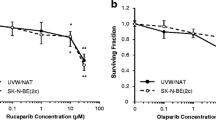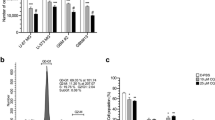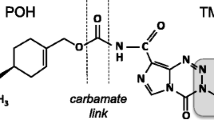Abstract
Purpose
The present study aimed to evaluate the new water soluble camptothecin analogue Namitecan (ST1968) in preclinical paediatric tumour models of the nervous system comprehensive of neuroblastoma, primitive neuroectodermal tumours/PNET and medulloblastoma where the drug was compared to Irinotecan.
Methods
Cellular sensitivity to the drug was assessed by MTT and clonogenic assays. Propidium iodide staining was used for cell cycle perturbation studies. The genotoxic effects were quantified by Comet assay, whereas apoptosis was assessed by PARP cleavage and sub-G1 accumulation. Tumour response was investigated in xenograft models in nude mice.
Results
The cellular response to Namitecan was heterogeneous with IC50 (2 h) ranging between 0.14 and 13.26 μM, whereas SN38 (the active metabolite of Irinotecan) appeared more effective (IC50: 0.03–11.7 μM). Interestingly, prolonged drug incubation times up to 72 h enhanced Namitecan cytotoxicity, with similar colony inhibition curves between the two analogues (IC50, nM-SN38: 0.9 ± 0.2; Namitecan: 0.7 ± 0.4). DNA damage, accumulation in late-S/G2 phases and induction of apoptosis appeared important players of Namitecan cytotoxicity in our models. In vivo, Namitecan was superior to Irinotecan in three out of five xenograft models, with reversible weight loss (10 %). In the sensitive SK-N-AS xenograft, Namitecan showed a high retention in tumours consistently with: high antitumour response, rapid drug-mediated DNA damage (60 % mean TailDNA after 1 h from drug inoculation), persistent cell cycle perturbation (60–40 % G2 accumulation after 48–72 h, respectively) and apoptosis. Studies with Namitecan and platinum agents in this model showed a significant enhancement of antitumour activity of the drugs combination versus single agents.
Conclusions
Our preclinical data strongly support the interest of further investigations on the well-tolerated Namitecan either as a single agent or in combination in paediatric oncology.






Similar content being viewed by others
References
Ries LA, Eisner MP, Kosary CL et al (2005) SEER cancer statistics review 1975–2002. National Cancer Institute BM
Houghton P, Cheshire P, Hallman J et al (1995) Efficacy of topoisomerase I inhibitors, topotecan and irinotecan, administered at low dose levels in protracted schedules to mice bearing xenografts of human tumours. Cancer Chemother Pharmacol 36:393–403
Hare C, Elion G, Houghton P et al (1997) Therapeutic efficacy of the topoisomerase I inhibitor 7-ethyl-10-(4-[1-piperidino]-1- piperidino)-carbonyloxy-camptothecin against pediatric and adult central nervous system tumour xenografts. Cancer Chemother Pharmacol 39:187–191
Vassal G, Terrier-Lacombe M, Bissery M et al (1996) Therapeutic activity of CPT-11, a DNA-topoisomerase I inhibitor, against peripheral primitive neuroectodermal tumour and neuroblastoma xenografts. Br J Cancer 74:737–745
Vassal G, Boland I, Santos A et al (1997) Potent therapeutic activity of irinotecan (CPT-11) and its schedule dependency in medulloblastoma xenografts in nude mice. Int J Cancer 73:156–163
Pisano C, De Cesare M, Beretta GL et al (2008) Preclinical profile of antitumor activity of a novel hydrophilic camptothecin, ST1968. Mol Cancer Ther 7:2051–2059
Pisano C, Zuco V, De Cesare M et al (2008) Intracellular accumulation and DNA damage persistence as determinant of human squamous cell carcinoma hypersensitivity to the novel camptothecin ST1968. Eur J Cancer 44:1332–1340
De Cesare M, Beretta GL, Tinelli S et al (2007) Preclinical efficacy of ST1976, a novel camptothecin analog of the 7- oxyiminomethyl series. Biochem Pharmacol 73:656–664
Cassinelli G, Zuco V, Petrangolini G et al (2012) The curative efficacy of namitecan (ST1968) in preclinical models of pediatric sarcoma is associated with antiangiogenic effects. Biochem Pharmacol 84:163–171
Dallavalle S, Ferrari A, Biasotti B et al (2001) Novel 7-oxyiminomethyl derivatives of camptothecin with potent in vitro and in vivo antitumor activity. J Med Chem 44:3264–3274
Singh NP, Graham MM, Singh V, Khan A (1995) Induction of DNA single-strand breaks in human lymphocytes by low doses of gamma-rays. Int J Radiat Biol 68:563–569
Malyapa RS, Bi C, Ahern EW, Roti Roti JL (1998) Detection of DNA damage by the alkaline comet assay after exposure to low dose gamma radiation. Radiat Res 149:396–400
Di Francesco AM, Riccardi A, Barone G et al (2005) The novel lipophilic camptothecin analogue gimatecan is very active in vitro in human neuroblastoma: a comparative study with SN38 and topotecan. Biochem Pharmacol 70:1125–1136
Huang P, Olive PL, Durand RE (1998) Use of the Comet assay for assessment of drug resistance and its modulation in vivo. Br J of Cancer 77:412–416
Burlinson B, Tice RR, Speit G, Agurell E, Brendler-Schwaab SY, Collins AR, Escobar P, Honma M, Kumaravel TS, Nakajima M, Sasaki YF, Thybaud V, Uno Y, Vasquez M, Hartmann A (2007) Fourth International Workgroup on Genotoxicity testing: results of the in vivo Comet assay workgroup. Mutat Res 627:31–35
Bomgaars L, Berg SL, Blaney SM (2001) The development of camptothecin analogs in childhood cancers. Oncologist 6:506–516
Rapisarda A, Zalek J, Hollinghead M, Braunschweig T, Uranchimeg B, Bonomi CA, Borgel SD, Carter JP, Hewitt SM, Shoemaker RH, Melillo G (2004) Schedule-dependent Inhibition of Hypoxia-inducible Factor-1α protein accumulation, angiogenesis, and tumor growth by Topotecan in U251-HRE glioblastoma xenografts. Cancer Res 64:6845–6848
Kaneko M, Kaneko S, Suzuki K (2009) Prolonged low-dose administration of the cyclooxygenase-2 inhibitor celecoxib enhances the antitumor activity of irinotecan against neuroblastoma xenografts. Cancer Sci 100:2193–2201
Zage PE, Graham TC, Zeng L, Fang W, Pien C, Thress K, Omer C, Brown JL, Zweidler-McKay PA (2011) The selective Trk inhibitor AZ623 inhibits brain-derived neurotrophic factor-mediated neuroblastoma cell proliferation and signaling and is synergistic with topotecan. Cancer 117:1321–1391
Bagatell R, London WB, Wagner LM, Voss SD, Stewart CF, Maris JM, Kretschmar C, Cohn SL (2011) Phase II study of irinotecan and temozolomide in children with relapsed or refractory neuroblastoma: a Children’s Oncology Group study. J Clin Oncol 29:208–213
London WB, Frantz CN, Campbell LA, Seeger RC, Brumback BA, Cohn SL, Matthay KK, Castleberry RP, Diller L (2010) Phase II randomized comparison of topotecan plus cyclophosphamide versus topotecan alone in children with recurrent or refractory neuroblastoma: a Children’s Oncology Group study. J Clin Oncol 28:3808–3815
Donfrancesco A, De Ioris MA, McDowell HP, De Pasquale MD, Ilari I, Jenkner A, Castellano A, Cialfi S, De Laurentis C, Dominici C (2010) Gefitinib in combination with oral topotecan and cyclophosphamide in relapsed neuroblastoma: pharmacological rationale and clinical response. Paediatr Blood Cancer 54:55–61
Acknowledgments
This work was supported by Fondazione per l’Oncologia Pediatrica (FOP). The authors thank Sigma-Tau (Rome, Italy) for supplying Namitecan. We also thank S. Dottori (Sigma-Tau S.p.A) for its excellent technical assistance. Namitecan is under Clinical Trial sponsored by Sigma-Tau.
Conflict of interest
Dr Pisano Claudio and Dr Federica Bucci are full employed by Sigma-Tau.
Author information
Authors and Affiliations
Corresponding author
Additional information
Daniela Meco and Angela Maria Di Francesco equally contributed to this work.
Rights and permissions
About this article
Cite this article
Meco, D., Di Francesco, A.M., Cusano, G. et al. Preclinical evaluation of the novel 7-substituted camptothecin Namitecan (ST1968) in paediatric tumour models. Cancer Chemother Pharmacol 70, 811–822 (2012). https://doi.org/10.1007/s00280-012-1973-0
Received:
Accepted:
Published:
Issue Date:
DOI: https://doi.org/10.1007/s00280-012-1973-0




